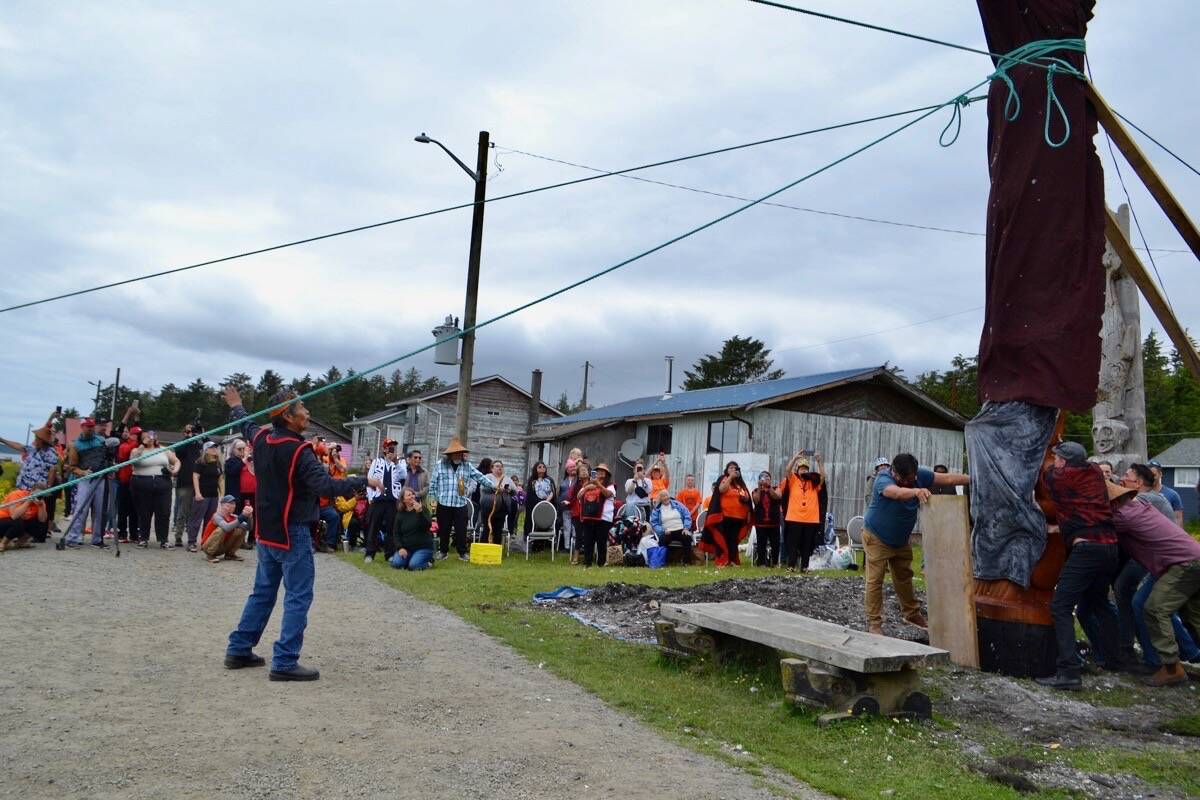Calm seas and overcast Canada Day skies welcomed family, friends and visitors to the ancient Vancouver Island village of Opitsaht on July 1 to bear witness to a historical totem pole raising ceremony.
People started arriving at approximately 10 a.m. and the totem pole was raised at 12:05 p.m. Located across the inlet from Tofino, Opitsaht is the origin place of the Tla-o-qui-aht First Nation people and is only accessible by water.
Master carver Joe Martin orchestrated the pole raising, which involved a string of people tugging on three blue ropes in the front and one rope in the back, while many more pushed the 32-foot pole from behind then swiftly shovelled mounds of soil around the base to seal the foundation. Elder Levi Martin could be heard chanting throughout the entire production.
A couple of days before the ceremony, the totem pole or Čiinuł as it’s called in Nuu-chah-nulth language was trucked then barged from its carving bay at the Naa’Waya’Sum Coastal Indigenous Gardens (formerly the Tofino Botanical Gardens).
A crane was used to lift it off the barge and onto the shores of Opitsaht.
Martin carved the totem pole for Chief Nookmis of the House of Ewos of the Tla-o-qui-aht with help from carvers Gordon Dick, Ken Easton, Robinson Cook, Patrick Amos, Robin Rorick and his daughter, Gizele Martin.
“The totem pole represents our truth and where we came from. We can’t begin to reconcile until we recognize where we came from,” Tla-o-qui-aht family member Mary Martin told the crowd during the unveiling.
Joe Martin described the top crest of the totem pole.
“On top is a female Thunderbird and the crest of the moon on the chest of the Thunderbird. And that is about the first teaching and the first law, and that is about respect. That began when our mothers conceived our lives and our elders would come and sit there and teach us by the way of using lullabies,” he said, noting that the Thunderbird with the wings closed depicts Tla-o-qui-aht female ancestry and the ones with the wings open depicts male ancestry.
Gizele Martin spoke about the bottom crest of the totem pole.
“The non-binary youth or child is being held by the wolf and being re-initiated into our culture and our teachings,” Gizele shared.
Gizele, a cultural and Indigenous language guardian, said the name of the pole is ‘Hinaaqsuuqʷa’, named after truth-speaking orator who was her great-grandfather’s great-grandfather’s dad.
Between the top and bottom crests, there is a sea serpent and lighting in the sky to represent the connection to the super natural and a deer to represent strength. There are two faces, one represents the ancestors and their teachings and the other face with the tongue sticking out speaks about Indian Residential Schools (IRS) and those that never made it home.
Below the face with the tongue sticking out are three skulls, representing the deaths at IRS, missing and murdered Indigenous women and girls, and death from disease like smallpox and COVID-19.
Gizele carved the skulls.
“I felt most at peace while working on them and thinking about those issues,” she said, noting that the totem pole is like an “encyclopedia of their history” and the stories shared during the July 1 ceremony are just a sliver.
 Gizele Martin speaks about the bottom crest of the totem pole. (Nora O’Malley photo)
Gizele Martin speaks about the bottom crest of the totem pole. (Nora O’Malley photo)
Co-founder of the Isaak Olam Foundation. Eli Enns. spoke about the history of Opitsaht. He said at one point, the village was home to 10,000 and had 200 longhouses with totem poles outside every house. In 1792, American sea merchant Robert Gray bombarded the village, burning the houses and totems to the ground.
Former elected Tla-o-qui-aht chief Moses Martin addressed the crowd. He thanked MLA Josie Osborne, MP Gord Johns and Tofino mayor Dan Law for attending the ceremony.
“I am so proud of my family. They listened to what they were taught and now they are living it,” said Moses Martin.
Opitsaht’s new totem pole was carved from an 800-year-old log that was salvaged from the Canoe Creek hydro project. According to carver Robinson Cook, the log had been lying on the ground for over a decade.
“It’s an extraordinary tree. It has very few knots and it’s really, really nice to carve,” he told the Westerly during a gathering in the longhouse after the ceremony.
The other half of the Canoe Creek log is also being transformed into a totem pole. It will be raised this coming September during the Carving on the Edge Festival.
RELATED: Rekindling culture: Project brings totems back to Opitsaht
VIDEO: Tla-o-qui-aht totem pole raised in Tofino
READ MORE: Totem pole unveiled in Port Alberni

